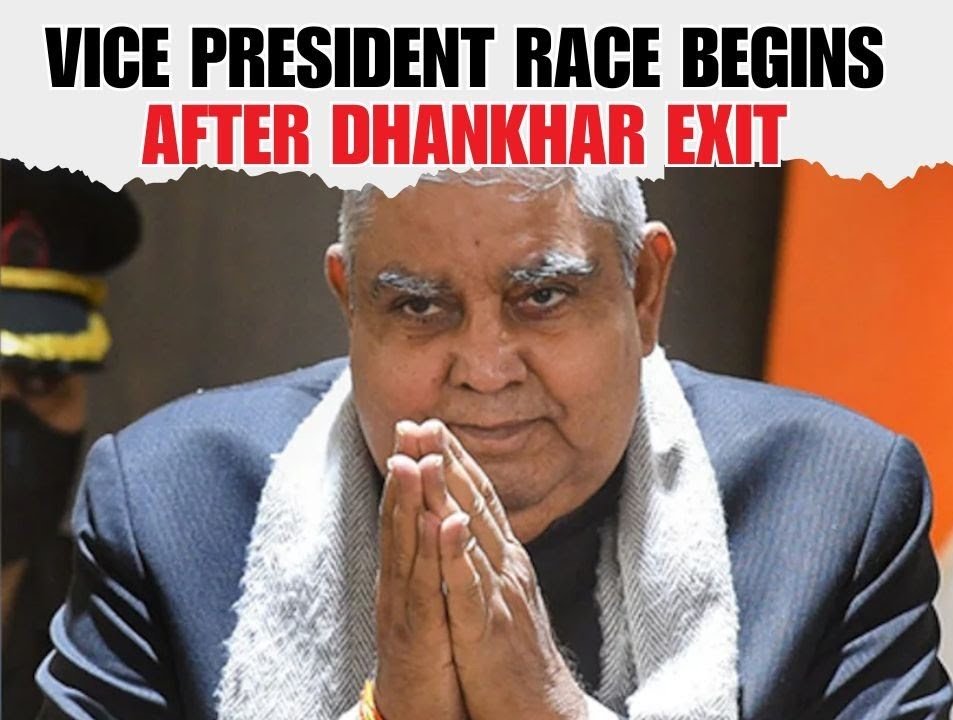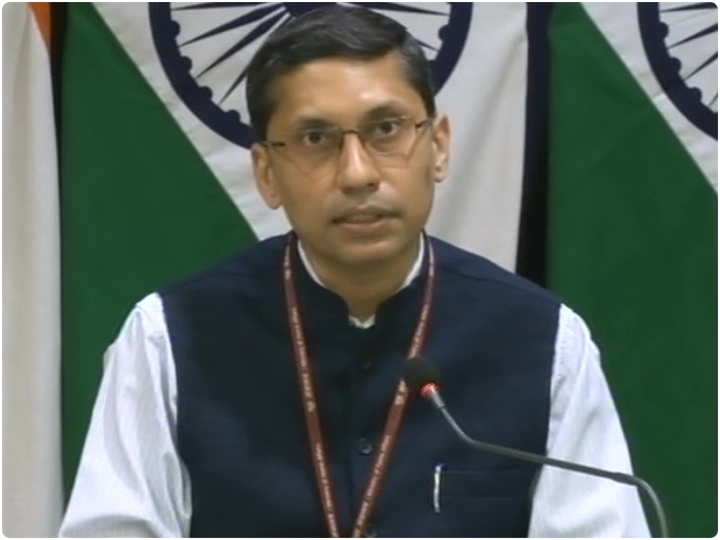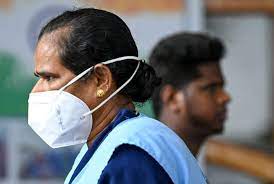The Race for India’s Next Vice President Heats Up After Dhankhar’s Exit
By: Javid Amin | Srinagar | 24 July 2025
A Resignation That Sparked a Political Shuffle
In a surprise turn of events, Jagdeep Dhankhar, the Vice President of India and Chairman of the Rajya Sabha, tendered his resignation citing health concerns. The move has sent political ripples through New Delhi’s corridors of power, opening the floor for a high-stakes contest for the country’s second-highest constitutional office.
As the Vice President’s role is not just ceremonial but includes presiding over the Upper House and acting as the constitutional backup to the President of India, the selection of Dhankhar’s successor will be closely watched both domestically and internationally.
The buzz in political circles is loud and growing. Several probable contenders have emerged—some predictable, some surprising, and others straight out of the realm of political daydreaming.
In this comprehensive guide, we break down the frontrunners, surprise names, institutional procedures, political calculations, and the wildcards in play.
Why the Vice President of India Matters
The Second-Highest Constitutional Post
The Vice President of India:
-
Is the ex-officio Chairman of the Rajya Sabha
-
Steps in for the President in case of absence or resignation
-
Represents the nation in formal and constitutional events
-
Plays a neutral role in managing Upper House proceedings
With increasing political friction in Parliament, especially over contentious bills and debates, the Chairperson’s impartiality and experience matter more than ever.
The Shock Exit: Why Did Jagdeep Dhankhar Resign?
Jagdeep Dhankhar’s resignation was unexpected but dignified. In a statement released to the media, Dhankhar cited persistent health complications that would “not allow him to serve the office with the full attention and rigor it demands.”
While opposition leaders have praised his conduct in office, some political observers suspect a larger reshuffle might be at play—possibly linked to cabinet restructuring or gubernatorial shifts.
Regardless, Dhankhar’s exit has unlocked one of the most important succession races in Indian politics.
Frontrunners in the Vice Presidential Race
Harivansh Narayan Singh: The Leading NDA Bet
Credentials:
-
Deputy Chairman, Rajya Sabha
-
Senior leader from Janata Dal (United)
-
Known for bipartisan respect and procedural experience
Harivansh Narayan Singh is widely seen as the top contender within NDA circles. As a parliamentarian with deep administrative expertise, he checks multiple boxes:
-
Continuity in Rajya Sabha leadership
-
Regional representation from Bihar
-
Acceptance across BJP, JD(U), and even some opposition benches
He is currently presiding over Rajya Sabha proceedings until the new VP is elected.
Nitish Kumar: The Evergreen Speculative Pick
Profile:
-
Chief Minister of Bihar
-
JD(U) chief and seasoned political survivor
-
Known for swinging alliances and surprise moves
While Nitish Kumar has not expressed interest, speculation persists. Some analysts believe the BJP may offer the position to ease him out of Bihar and into a ceremonial constitutional role, thereby reshaping the state’s political landscape.
However, given Nitish’s recent return to opposition alliance INDIA, the likelihood has diminished—yet it remains a floating possibility, especially if political equations shift yet again.
Ram Nath Thakur: Legacy and Leverage
Background:
-
Minister of State for Agriculture
-
Son of socialist icon Karpoori Thakur
-
JD(U) member and close to BJP leadership
Ram Nath Thakur’s name entered the conversation after BJP chief JP Nadda reportedly met him in a closed-door meeting. His credentials bring:
-
Social justice symbolism (his father is a Bharat Ratna awardee)
-
Generational political continuity
-
Representation from the EBC (Extremely Backward Classes) segment—a key voter base in north India
Political observers note that his appointment would send a strategic message heading into the next Lok Sabha elections.
Manoj Sinha: Technocrat in Transition?
Current Role:
-
Lieutenant Governor of Jammu & Kashmir
-
Former MoS for Communications
-
Known for his administrative acumen and low-profile efficiency
Manoj Sinha represents a governance-first face of the BJP. With the Centre expected to restore full statehood to J&K soon, Sinha may be relieved from his duties—making him available for higher constitutional responsibilities.
His profile aligns with:
-
BJP’s preference for loyalty and governance over mass appeal
-
A soft-spoken, apolitical temperament suitable for the Vice President’s chair
The “Daydreamers”: Unlikely but Not Impossible Picks
Mukhtar Abbas Naqvi: The Forgotten Loyalist
Former Minority Affairs Minister, Mukhtar Abbas Naqvi, was once seen as BJP’s Muslim face, but has been politically sidelined after his Rajya Sabha term ended. His rehabilitation through a constitutional post is a possibility—particularly to counter the opposition’s minority representation narrative.
Sudha Murty: Social Icon Turned Constitutional Figure?
Author, philanthropist, and Infosys Foundation chair, Sudha Murty, recently made waves after being nominated to the Rajya Sabha by the President. While her elevation to VP might seem unlikely, it would mirror BJP’s past surprise picks like Droupadi Murmu for the presidency.
Her profile brings:
-
Gender and regional balance
-
Soft power appeal
-
A clean, apolitical public image
General (Retd.) VK Singh: From Battlefield to Rajya Sabha?
Former Army Chief and Union Minister, General VK Singh, remains respected in strategic circles, though politically quieter recently. His elevation would emphasize national security, stability, and continuity of service.
It would also solidify BJP’s appeal to defense veterans and voters who value strong leadership.
Ghulam Nabi Azad: The Diplomat Without a Party
Former Leader of Opposition in Rajya Sabha, Ghulam Nabi Azad commands deep respect across political lines. His oratory, moderation, and institutional memory are unmatched. Now heading his own party (DPAP) in Jammu & Kashmir, he remains politically active but isolated from the national power core.
His name surfaces in constitutional discussions for:
-
His parliamentary experience and legal acumen
-
A gesture of outreach to Kashmir
-
Symbolic Muslim representation at the highest level
Still, his distance from major alliances and break from Congress make this a beautiful but improbable possibility.
Farooq Abdullah: The Statesman of Yesteryears
A three-time Chief Minister of J&K and former Union Minister, Farooq Abdullah remains one of the most charismatic and controversial figures in Indian politics.
Why he fits the VP fantasy list:
-
Rich parliamentary and administrative experience
-
A symbolic nod to Kashmir’s political mainstream
-
A chance to project national integration ahead of crucial elections
But Farooq’s blunt rhetoric, age, and oppositional stance to the BJP mean his name is likely to remain just coffee-table speculation—unless consensus politics takes a very unexpected turn.
Other Honorable Mentions in the “VP Dreamers Club”
Sushilkumar Shinde
-
Former Union Home Minister
-
Dalit leader with vast parliamentary experience
-
Low-profile but respected
Najma Heptulla
-
Former Minority Affairs Minister and Governor
-
Experienced Rajya Sabha leader
-
Age and political retirement reduce viability
Kapil Sibal
-
Legal heavyweight and ex-Union Minister
-
Known for his constitutional expertise and fiery debates
-
Seen more as a legal warrior than a consensus VP
Dr. K. Kasturirangan
-
Eminent scientist and educationist
-
A non-political VP is always a possibility
-
Has served on numerous national missions and panels
Why the “Daydreamers” Still Matter
Even if they aren’t nominated, these names matter because they:
-
Reflect what India could symbolically offer its electorate
-
Stir public and media imagination
-
Influence alliances and backdoor negotiations
In a hyper-strategic BJP era, these figures may not reach the VP chair—but their ideological weight and public sentiment still impact political discourse.
The Election Process: What Happens Now?
The Vice Presidential election is governed by Article 66 of the Constitution and conducted by the Election Commission of India. Here’s how the process unfolds:
Electoral College:
-
Members of both Lok Sabha and Rajya Sabha vote (including nominated members)
-
The total strength is currently 788 MPs
Voting System:
-
Secret ballot using the Single Transferable Vote (STV) system
-
Each MP ranks the candidates in order of preference
-
The candidate securing a majority of first-preference votes wins
Timeline:
-
As of now, no official date has been announced
-
Once notified, the process—from nomination to result—takes about 30 days
Interim Arrangements:
Until a new Vice President is elected, Harivansh Narayan Singh, as Deputy Chairman, will preside over Rajya Sabha proceedings.
Will BJP Spring a Surprise?
Political analysts remain cautious in making predictions. The BJP, under Narendra Modi’s leadership, has a track record of choosing surprise candidates for top constitutional posts:
-
Ram Nath Kovind for President in 2017
-
Droupadi Murmu for President in 2022
-
Om Birla for Lok Sabha Speaker
These picks were not only unexpected but highly symbolic, often selected to balance caste, region, and social representation.
Hence, even though names like Harivansh Narayan Singh dominate the current narrative, the actual nominee could be someone completely off the radar.
Political Strategy: Beyond Just a Nomination
The Vice Presidential choice will signal BJP’s:
-
Coalition management strategy (especially with JD(U) and regional parties)
-
Social engineering priorities (EBC, SC, ST, women, minorities)
-
Future Rajya Sabha dynamics (who chairs debates, bills, and motions)
This appointment is not just about symbolism—it’s about power equilibrium.
What the Opposition Is Watching For
The Congress and INDIA bloc are closely monitoring:
-
Whether the BJP fields a consensus candidate
-
Scope for putting up a joint opposition nominee
-
Timing of the election vis-à-vis Parliament sessions
While BJP’s numbers make it virtually impossible to stop their nominee, the opposition could use the election to amplify political messaging—especially if the ruling party picks a polarizing figure.
Who Has the Numbers?
Let’s look at the math:
NDA’s Approximate Strength:
-
Lok Sabha: 293 MPs (BJP + Allies)
-
Rajya Sabha: 110 (variable with recent gains)
Estimated Total = ~403 (Majority is 395)
This gives the NDA a comfortable edge, but some allies are unpredictable (like JD(U), Shiv Sena factions, and TDP). If BJP goes solo with a hardline pick, the opposition might exploit cracks.
Bottom-Line: A High-Profile Vacancy, A Critical Decision
The race for India’s Vice President is not just about who presides over the Rajya Sabha—it’s about what kind of leader the country needs in times of legislative deadlock, political polarization, and democratic scrutiny.
As speculations intensify, the eventual nominee will carry the burden of neutrality, dignity, and constitutional responsibility.
Whether it’s an old guard like Harivansh Narayan Singh or a surprise technocrat like Manoj Sinha—or even a wildcard like Sudha Murty—the decision will shape the tone of Indian parliamentary politics for years to come.



